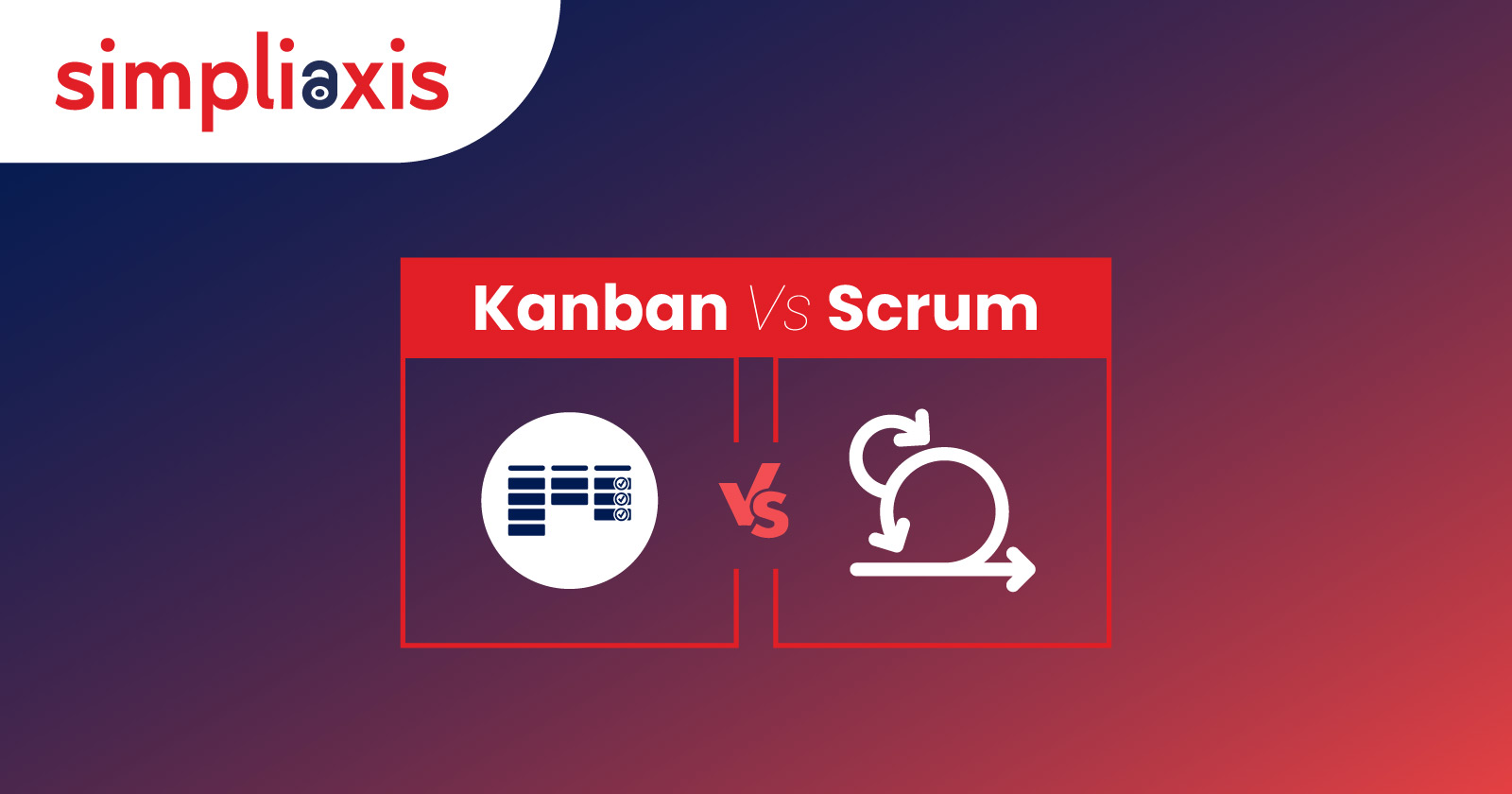Kanban vs Scrum are project management methods that split tasks into small steps to improve the process. However, Scrum involves implementing timelines for each delivery cycle and reviewing the achievements. Kanban helps you visualize the jobs so that you can continue the workflow. Kanban vs Scrum are both flexible frameworks. Simply put, Scrum and Kanban are flexible and transparent, which makes agile effective. Selecting one is not always mandatory; you can use both to maximize the benefits.
This article discusses each method and breaks it down to help you understand Scrum vs Kanban differences. It also compares the two and explains which will be helpful in your project: the Scrum board vs Kanban board.
What is Kanban?
It is a visual way to manage projects that tracks progress and eliminates impediments or problems. The heart of the Kanban method is a physical or digital Kanban board. The jobs are divided into different columns, written on columns that move from one to the next until they are all accomplished.
Using Kanban has many benefits, such as clarifying what tasks must be done and where they are piling up. Also, graphic representation helps determine the assigned resources and eliminates waste. Some sensible things about using Kanban are:
It improves the visibility of the process flow.
The methodology increases the speed of product delivery.
It enhances the predictability of the project.
Kanban improves the alignment between business goals, key results, and product delivery.
The Kanban methodology uses principles from both Lean and Agile. It can be efficiently combined with other methods and often collaborates with Scrum to create a hybrid process known as Scrumban. Market research in 2022 suggested that 27% of agile users use Scrumban, and 56% use Kanban.
Core Concepts of Kanban Methodology
Kanban vs Scrum, which one is best for your team, is a complicated answer. However, you need to know the details of each framework to make a wise decision. Here are the core concepts of Kanban decoded:
DoW: The definition of workflow represents the key parts of the Kanban workflow. It helps visualize the units that move through the board and the time required to progress columns or complete tasks.
WIP limits: Work progress limits set by the team in a column or on the entire board. Therefore, you cannot have more than five cards at a time if you have a column with five WIP limits. Before starting another one, your team must tackle the previous five and move to the new one. Thus, WIP helps to avoid the risk of bottlenecks in the process.
Kaizen: It indicates improvement and encourages a mindset to improve the process. The process allows all team members to share their process insights to enhance teamwork and achieve the goal.
Read more: Core Practices of Kanban
What is Scrum?
Scrum is an Agile approach to managing complex projects. It is best for projects that require frequent changes for adaptation. The main parts of Scrum are sprints, which last one week to one month. A Scrum team is also a small, self-organized group with a Product Owner, a Scrum master, and a Development Team. In Agile, Scrum uses a method called "iteration" to finish a job. Hence, it allows the team to focus on stage-wise completion of the overall project. Thus, the team avoids delivering the whole project at a glance and completes the task in stages. It enables the development team to incorporate the changes based on evolving priorities.
The Three Pillars of Scrum
The most important Scrum pillars are:
Transparency: It is necessary to maintain transparency throughout the task. Also, Scrum ensures transparency and keeps team members and stakeholders on the same page regarding project advancement.
Adaptation: It is an adaptive methodology that embraces the changes in every stage of development. Therefore, it can easily accommodate the changes in ongoing projects with tactical moves.
Inspection: The Scrum framework allows team members and stakeholders to inspect the project's consistency, ultimately encouraging improvement in the project's outcome.
In addition, it has five core values: courage, focus, commitment, respect, and openness. The values emphasize clear communication and transparency in the process.
Read More: Five Events Of Scrum
Kanban vs. Scrum: Similarities and differences
The resemblances and differences between Kanban vs Scrum are listed below:
Both methodologies encourage projects to accept the changes and engage all team members in the product. Furthermore, Kanban vs Scrum techniques ensure short development cycles to increase transparency in the process.
Scrum is a methodology that helps structure the workflow and motivates the team to deliver projects in short timelines. On the other hand, Kanban helps visualize the tasks needed to complete the project.
Scrum delivers chunks of deliverables in one to four week periods while Kanban delivers tasks continuously.
Kanban Vs Scrum:
Features | Scrum | Kanban |
Process
| During sprints in Scrum, the team follows the Plan-Do-Check-Act (PDCA) cycle. Scrum might be a better way to do complex, repetitive work, such as creating a new product or feature. | Never-ending flow. When a Kanban task is finished, the team moves on to the next one. Kanban works better for work that needs to keep moving, and repetitive work. |
Planning
| Sprint planning and daily scrum help in planning the sprint. | There is no specific way to check and change things. One way work moves is forward. |
Roles and Responsibilities | Each person on the team has a clear job role. The Scrum master sets deadlines, the Product owner sets goals and targets, and the team members do the work. | There are no set roles for everyone on a team. However, the project manager is there to ensure everyone works together. |
Work In Progress
| The Scrum team decides how much work will be done in a sprint. Once the old work is completed, new works are added. | As soon as one job is done, start a new one. Kanban is helpful for teams that keep working on the same thing repeatedly. |
Prioritization of Work
| It also has a "pull system," but the whole batch is pulled for each version.
| It has a "pull system" workflow that says team members can only "pull" new jobs after finishing the existing work. |
Modifications
| Changes during the sprint are strongly avoided.
| Changes can be made in the middle of a job, which lets it go through iterations and keep improving until it is done. |
Measurement of Productivity
| Uses velocity through sprints to measure output. Because each sprint depends on the success of the one before it. | Cycle time, or the time it takes to finish one whole piece of work from start to finish, is used to measure production. |
Best Applications
| It is best for teams with stable priorities and goals that might not change much over time. | It is best for projects with variable priorities. |
Kanban vs Scrum: Which One is The Best
Both Scrum and Kanban offer practical solutions using agile approaches. Agile Scrum vs. Kanban boards help project managers manage their projects more effectively. However, you must understand which method best aligns with your organization’s goals. If your team prioritizes higher productivity and more rapid delivery in iterations, the Scrum framework is your optimal choice. This framework allows for greater flexibility to accommodate feedback and changing product requirements.
On the other hand, Kanban is a better option for the team because it emphasizes continuous delivery instead of fixed-time delivery. It helps the team manage small projects or supervise the ongoing projects. Therefore, frequent small tasks fix the problem and improve the product quality. However, your organization can use both methodologies to achieve a more superficial impact and complete the projects more positively.
Read More: 3 Differences Between Scrum and Kanban You Need to Know
Kanban vs. Scrum: Are You Indecisive?
It is complicated to understand which is better for your organization. However, multiple companies are using hybrid ScrumBan models to manage their projects. It is always better to allow your teams to choose which agile features work best for them, whether Scrum, Kanban, or ScrumBan. Rather, implementing one framework on day one, team-managed projects allow you to progressively layer on more and more powerful features as you learn what works for your team.
ScrumBan uses sprints, standups, and retrospectives, which are stable parts of Scrum. After that, Kanban's visual process and limits on work-in-progress are added. This makes a method that can handle jobs of any size. Scrumban began as an easy way for teams to switch from Scrum to Kanban. It has since become a mature system that lets teams work on complex, ongoing tasks. It's adaptable because it uses a mix of approaches and gives teams many Agile tools.
How Simpliaxis Helps Implement Scrum and Kanban
Kanban vs Scrum, both frameworks are crucial for Agile. Kanban works well when used with Scrum or any other Agile process. However, Kanban helps to visualize and improve workflow in a project. Scrum is an ongoing, incremental work method that gives you a lot of rules for how to do your job. Sprint is essential in Scrum; one sprint must finish a piece of work before the next one can start. Simpliaxis can help you learn more about Scrum in a better way through CSM certification training. You can also learn Kanban through our Professional Scrum with Kanban™ (PSK) Training. It allows you to get professional expertise in applying different methodologies that your organization requires to achieve its goals.



















